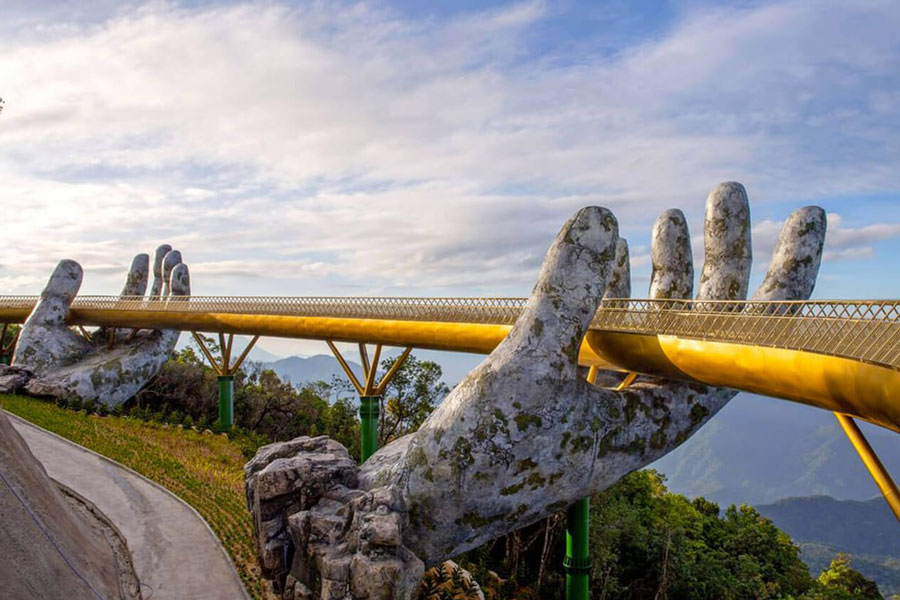hoi an daily tours
Hoi An Tours Overview
Located on the bank of Thu Bon River, Hoi An is a popular tourist town famous for its typical Vietnamese riverside town and idyllic countryside area nearby as well as a white sand beach of Cua Dai. The old town of Hoi An was recognized as a Cultural World Heritage site by UNESCO. Hoi An is well preserved and still keep its core of historic architecture, a stunning mix of Vietnamese, Japanese, Chinese, and European styles from 18 century. At Vietnam Real Tour, we offer a wide choice of Hoi An tours, day trips, and excursions in Hoi An as well as to some nearby highlights. Each of our tours to Hoi An is well designed with interesting activities and visiting sites.
See the best of Hoi An has to offer, touch the amazing Vietnamese history & taste delicious Hoi An’s delicacies through our Hoi An tours. If you do not find any suitable Hoi An tours on this page. Please keep in mind that we can tailor your tour to meet your unique needs. Contact Vietnam Real Tour now for a best Hoi An tours.
Hoi An Heritage and Hoi An Attractions
As a well-conserved model of Southeast Asia trading port from 15th to 19th century with unique constructions blending local and international cultures, in 1999, Hoi An Ancient Town was declared a UNESCO World Heritage Site.
In this ancient town, there are a number of tourist attractions where you can have some insights to the history and culture of the regions.
– Japanese bridge (Chua Cau): Connecting Nguyen Thi Minh Khai street and Tran Phu street, Chua Cau is a 20m-bridge constructed by the Japanese. The bridge dates back to the 16th century when foreign trade was at its glory days; so the Japanese trading community built it to connect with the Chinese area on the other side of a river.
– Old House of Tan Ky: This house is a stereotype of 18th merchant’s inhabitants in the commercial port. Tan Ky in English means “the Progress Shop”, which demonstrated the wish for being prosperous. The house was also a living space of two generations of a business family. Nowadays, it is located at 101 Nguyen Thai Hoc Street of Hoi An Ancient House.
– Hoi An Traditional Art Performance Theatre: the theater performs Vietnamese folk music and dance. Although the place was not spacious, it gives audience a sense of coziness and comfortable feelings with the sound of music and facial expressions of the artists. The theatre could be found at 75 Nguyen Thai Hoc Street.
– Kim Bong Carpentry Village: Originally, the village was located in the north of Vietnam. Since the 16th century, the craftsmen moved to the Central regions such as Hue and Hoi An to make building, furniture, royal tombs or architectural projects. Most of the works are the combination of Japanese, Chinese and Cham culture. Today, there are lots of things to do for tourists such as watching skillful artisans working with the crafts, seeing some historical relics or making their own products.
– Tra Que Herb Village: Just about 4km to the north of Hoi An Ancient Town, Tra Que is a small village between De Vong River and Tra Que alga pond. Due to the favorable nature and climate, the village could plant many kinds of herbs such as basil, coriander, lettuces or chameleon plant. Visiting the village could be a precious chance to learn vegetables growing techniques and enjoy good local meals.
– The Chinese Assembly Hall: Facing Thu Bon River, the building remains its vestige of the old time when Chinese people migrated here to do business. The Assembly Hall represents unique structure of Chinese with a great gate, a nice bonsai garden, a main hall and room for alter. Besides Chinese Assembly Hall, there are several halls that worth a visit such as Fujian Assembly Hall, Ngu Bang Assembly Hall, The Ghao-zhou Hall, Cantonese Assembly Hall and Hainan Assembly Hall.
Hoi An Ancient Town is an attractive destination for both domestic and international travelers. Booking a Hoi An Tour before you go is perfect and all you need is just enjoy your vacation in Vietnam.
Hoi An Tours Highlights
Hoi An Old Town is a small city in the northeast of Tam Ky, Quang Ngai Province. This region covers a total area of about 6027.25ha and houses over 80,000 inhabitants. Hoi An used to be an important trading port of Nguyen Dynasty in the 18th century to exchange goods from China, Spain, Japan, Portugal and Holland. Nowadays, Hoi An does not function as a trading port but primarily is a top travel destination. Anyone who comes to Vietnam is advised to pay at least once time to visit this old and beautiful town during their Vietnam vacation.
Hoi An location and geography
Hoi An district and the old town is located on the downstream of Thu Bon River. It is one of the coastal plains of Quang Nam Province, just approximately 28km to the Southeast of Da Nang. Hoi An have borders with Dien Ban District in the Northwest, Duy Xuyen District in the North and the South China Sea in the East.
Hoi An is the confluence of Quang Nam’s big rivers: Thu Bon, Truong Giang and Co Co. Most of the land area is connected with streams, rivers, sand dunes, pond, lakes and nipa palm forests. 18km away from Hoi An is Cu Lao Cham island where includes dozens of islands that are different in sizes and shapes. The islands form into a bow-like shape to protect the mainland.
Brief history of Hoi An
Between the second and the fourteenth century, Hoi An, which was originally called Lam Ap Pho, belonged to Champa and was a busy port for Chinese, Arabian and Persian businessmen. This town played an important role in the prosperity of Tra Kieu and My Son of Cham Cities. However, due to some historical factors, this land was ignored until 16th century. During four centuries from the 16th to the 19th, Chinese as well as Dutch, Indians, Japanese and Portuguese settled in Hoi An to do trade. Hoi An in Vietnamese means “a peaceful meeting place”. When the British and European came here, they called Hoi An “Faifo”.
In the 18th century, Hoi An was considered as the best destination for trading all over Southeast Asia. The major products were silk, ceramics, wood and metals. It is believed that the heart of the dragon lay under the ground of the city, making the business flourished.
Hoi An Daily Tours
Best Things to Do in Hoi An Ancient Town
Hoi An – The poetic riverside city has been an inspiration for many generations of Vietnamese poets, novelists, artists and has left a deep impression for every foreigner who has visited the country. Different from the other bustling cities of Vietnam, Hoi An enchants tourists by its charming beauty of landscape and people. This ancient city is packed with wonderful sights to see, special cuisine, unique colorful architecture and surrounded by gorgeous countryside. Here are top 5 things to do and see in Hoi An we recommended to you.
Wander around Hoi An Old Town
Hoi An Old Town gets the top position on the list of must-see destinations in Hoi An tours. As a major Southeast Asian trading post in the 15th to the 19th century, this ancient town is a special museum consisting of a series of historic buildings influenced by Chinese architecture. Zigzag on the narrow and winding roads of the town to explore many unique highlights such as the Japanese Covered Bridge, the three so-called Old Houses, and the Quan Cong Temple. Drop at a tailor’s shop to get a beautiful dress or suit. Remember to watch the incredible folk music performances held several times each day at the Hoi An Handicraft Workshop.wandering hoi an
Visit Tan Ky House
Tan Ky house was built by an ethnically Vietnamese family two centuries ago. This house is the most invaluable property which has been preserved through seven generations. This ancients house is a perfect combination of Chinese, Japanese and Vietnamese architecture. You can easily recognize the ceiling is affected by Japanese architectural styles with three progressively shorter beams or the Chinese characters are presented by columns decorated with special mother-of-pearl Chinese poems. Tourists will be impressed by the carving of crossed sabers wrapped in silk ribbon where force and flexibility converged.
Admire Japanese Covered Bridge
Like the iconic image of Hoi An, Japanese covered bridge impresses tourists by their pure beauty of being graceful curves and the inspiration for Zen spirit. This ancient bridge distinguishes itself by Japanese character unlike most other buildings in the old town, which are decorated according to flamboyant Chinese and Vietnamese architectural styles. This is such an ideal place for those who love taking photos, with a magnificent historical background and amazing red faded color. See it at night…awesome!japanese bridge in hoi an
Hit the Cua Dai beach
As one of the top beaches of Vietnam, Cua Dai is well-known for its pristinely soft white sand, crystal-clear yet deep blue water, crispy sunshine, cool salty breeze, slightly sloped sea floor and the gentle waves. This unspoiled and clean beach guarantees you an amazing experience. Relax on the deckchair and sip a cool cocktail or take part in a lot of fun activities, it depends on you. Do not skip this destination in your Hoi An tour if you are not a big fan of beaches!
Taste Cao Lau in Hoi An
Cao Lau is one of the most mouthwatering dishes you must try during your Hoi An tour. With the attractive brown color, unusual flavor, this unique dish satisfies everyone even fastidious people. It’s the combination of hand-cut noodles, sliced pork, crunchy rice crackers, spices, big handfuls of fresh herbs and super-tasty broth. Drop at a restaurant or stall in the riverside food market to taste this special dish.cao lau hoi an
Visit Tra Que vegetable village
You can easily realize that most meals in Hoi An also served with vegetables and herbs, so where your lunch is grown? Let’s find the answer! Located between town and An Bang beach, Tra Que fresh-veg village grows many types of vegetable from spring onions, tomatoes to hefty taro. Visitors can wander the plots, try to identify plants and chat with farmers there. Come to Baby Mustard restaurant for your delicious lunch and do not forget trying “three friends” – bundles of pork, prawn, and mint, tied with spring onion!
Soak Into Hoi An Night Market
Located on Nguyen Hoang Street, Hoi An night market is a paradise for shopaholics and foodies. The market opens around 5 pm every day when more than 500 vendors open up their stalls. The visitors will be mesmerized by a ton of local products from unique souvenirs to fresh fruits and mouthwatering streetfoods. Perhaps the most-spotted item for sale is the colorful paper lantern, which glows vividly after nightfall like a beautiful flower. Pick up a colorful lantern to cast a glow as you shop or take it home as a way to remember the colors, vibrant, and excitement of the Hoi An Night Market. A lantern is also a lovely gift for your friends.hoi an night market
Attending a Cooking Class
During your Hoi An tour, you will have a chance to discover how tasty the local cuisine truly is and bring home its flavor by taking a cooking class. It often starts with a tour around markets in Hoi An to buy fresh ingredients for the cooking lesson. Then you will learn how to mix all the flavors in the tasty treats. Nothing is more wonderful than cooking yourself delicious dishes and taste them. Names of recommendation are Red Bridge Cooking School and Gioan Cooking School.


